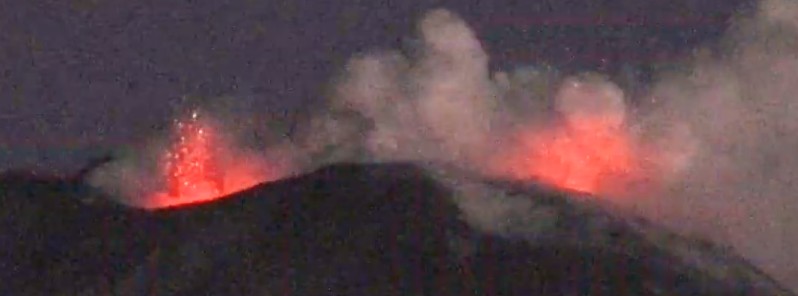Etna’s Southeast Crater erupting from two vents simultaneously, Italy


Take a look at the sublime display of Etna's natural fireworks, with its Southeast Crater now erupting from two vents simultaneously.
This video was recorded by INGV's Boris Behncke from Tremestieri Etnao on the southern side of Etna at daybreak on December 2, 2020.
Geological summary
Mount Etna, towering above Catania, Sicily's second-largest city, has one of the world's longest documented records of historical volcanism, dating back to 1500 BCE. Historical lava flows of basaltic composition cover much of the surface of this massive volcano, whose edifice is the highest and most voluminous in Italy.
The Mongibello stratovolcano, truncated by several small calderas, was constructed during the late Pleistocene and Holocene over an older shield volcano. The most prominent morphological feature of Etna is the Valle del Bove, a 5 x 10 km (5.1 x 6.2 miles) horseshoe-shaped caldera open to the east.
Two styles of eruptive activity typically occur at Etna. Persistent explosive eruptions, sometimes with minor lava emissions, take place from one or more of the three prominent summit craters, the Central Crater, NE Crater, and SE Crater (the latter formed in 1978). Flank vents, typically with higher effusion rates, are less frequently active and originate from fissures that open progressively downward from near the summit (usually accompanied by strombolian eruptions at the upper end).
Cinder cones are commonly constructed over the vents of lower-flank lava flows. Lava flows extend to the foot of the volcano on all sides and have reached the sea over a broad area on the SE flank. (GVP)
Featured image: Etna volcano on the morning of December 2, 2020. Credit: INGV/Boris Behncke

first read https://astronomy.com/news/2020/07/powerful-eruptions-on-the-sun-might-trigger-earthquakesremenber
then https://www.spaceweather.com/archive.php?view=1&day=01&month=12&year=2020
spaceweather.com POSSIBLE CME IMPACT TODAY DEc. 1,2020: NOAA analysts say there is a slight chance of a CME impact on Dec. 1st or 2nd. The storm cloud was launched into space by a major solar flare behind the sun’s east limb on Nov. 29th. Earth is on the very edge of the strike zone, meaning any blow would be glancing, sparking at most minor geomagnetic storms.